Plimoth Plantation
Two big events stand out in the history of Massachusetts, the arrival of the Pilgrim Fathers and the start of the American Revolution. While the story of the revolution is well told in and around Boston, the best place to find out about the Pilgrim Fathers is further south at Plymouth on the shores of Cape Cod Bay. The Puritans were an English Protestant group who wished to rid the Church of England of practises that they regarded as ‘Catholic’. English law blocked their ambitions and restricted their freedom to worship. The Pilgrim Fathers were originally a group of Puritans who sought to separate from the Church of England rather than reform it. They moved to the Netherlands in 1607 to escape persecution. Finding themselves in a minority in the Netherlands and fearing that their beliefs and culture could be swamped, they decided to move to Virginia and settle near the mouth of the Hudson River. In July 1620 the ship ‘Speedwell’ left Delfshaven carrying a group of colonists. It called at Southampton in England where other colonists were preparing to leave on the ship ‘Mayflower’. Both vessels departed in August 1620, but ‘Speedwell’ proved to be unseaworthy and had to be left at Plymouth, Devon. Thus 102 people left from Plymouth aboard the ‘Mayflower’ to start a new life. After a difficult voyage they arrived not at the Hudson River, but off the coast of Massachusetts where they settled. Plimoth Plantation recreates of the type of village that these early settlers would have built and also of the type of homesite that the local Indians occupied when Europeans arrived.
17th Century English Village
After sighting Cape Cod on November 9, 1620, the Mayflower attempted to continue on towards Virginia, but soon encountered dangerous currents and was forced to return to Cape Cod. Landing unexpectedly in Cape Cod caused some dissent among those on the Mayflower. This was not Virginia, and it lacked any form of government. Some wanted to continue to Virginia, some to go back to England and some wanted to settle. In the end they agreed that it was impracticable either to return or to continue onwards and they drew up the Mayflower Compact to agree how they would govern their settlement. Having explored Cape Cod and found it unsuitable for settlement, the Pilgrim Fathers moved across the bay to land at Plymouth. The 17th Century English Village at Plimoth Plantation is a re-creation of the settlement as it would have looked in 1627. It is open to the public year-round.
Cannon in Fort, 17th Century English Village
The settlers had no idea what challenges they might face. They could come under attack from Indian tribes or from a rival colonial power. There was no army or police force to protect them, so they had to make their settlement secure. A stockade was built around the village to keep any would-be attackers out, and a fort with cannon gave the settlers the ability to fight back if needed.
Interior of House, 17th Century English Village
The interiors of the buildings seem very authentic; they are dark, smelly, smoky and draughty. Many houses have only earthen floors. There is no electric light, air conditioning or picture windows here, or to put it another way, what the visitor sees looks and feels pretty authentic. The effort to make the village feel authentic continues outside, with gardens tended by rôle players using 17th century techniques and a variety of animals of the type that the settlers would have kept. Click Tab 2 to see a rôle player working in a garden.
Rôle player repairing building, 17th Century English Village
The buildings of the Pilgrim Fathers have long since been lost but care has been taken to make the re-created buildings at Plimoth Plantation accurate to the period based on local archaeological evidence. The realism is enhanced by rôle players in period dress who work and talk as the early settlers would have done. Click Tab 2 to see a close up of the rôle player at work.
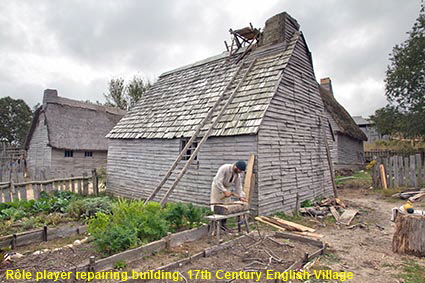
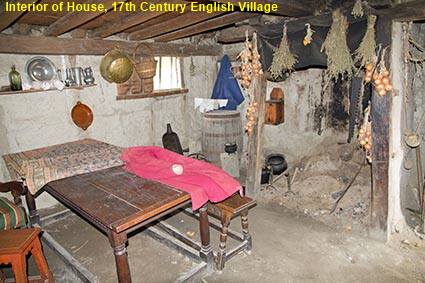
DLU171222
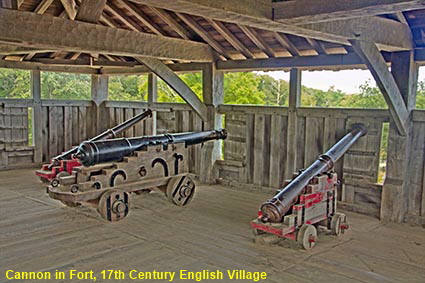
Click on Minimap to navigate
Home > US States > New England > Massachusetts > Cape Cod >


To move forwards or backwards through the Massachusetts trail click the arrows above, or select your next destination on the Minimap.
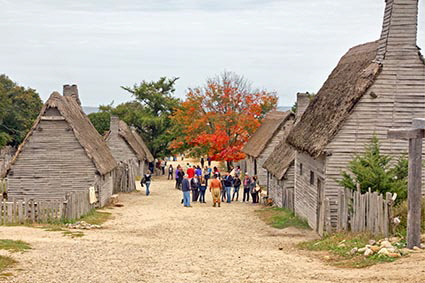
Bark covered house, Wampanoag Homesite
The area where the Pilgrim Fathers first landed on Cape Cod was the home of the Nauset Indians while the area where they settled was the home to the Wampanoag Indians. The Mayflower arrived at a time when the Indian population had crashed as a result of the spread of European diseases such as smallpox. When the Pilgrim Fathers looked for a site to build their settlement they found a clearing with a Wampanoag village in it. Disease had arrived a few years earlier and there was nobody left alive, the Pilgrim Fathers found only skeletons in the houses. The Wampanoag people called the village Patuxet, the Pilgrim Fathers decided that it was the ideal location for their settlement and named it Plymouth. The Wampanoag Homesite at Plimoth Plantation recreates an Indian Homesite from the time of early contact with Europeans. The Homesite is staffed by rôle players all of whom are native people dressed in historically accurate clothing. Unlike the English Village, the Wampanoag Homesite is open only in season. Click Tab 2 to see a rôle player burning of the inside of a tree trunk to create a dugout canoe.
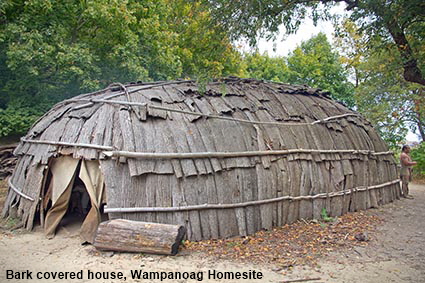
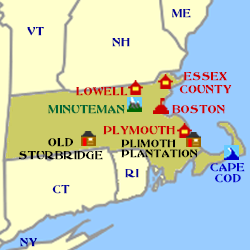

© Mike Elsden 1981 - 2025
The contents of this page may not be reproduced in full or in part without permission